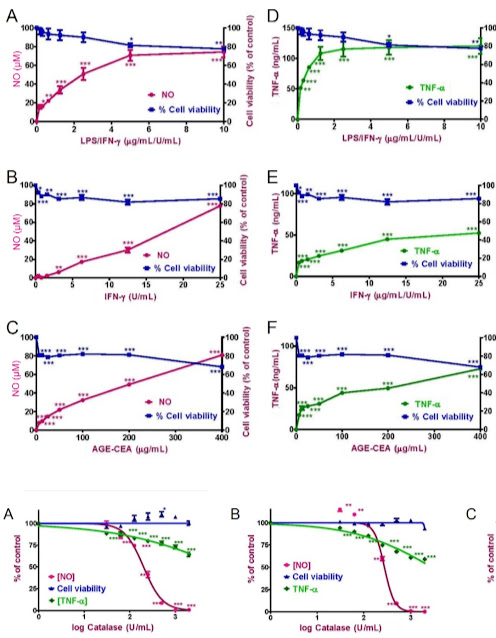Hydrogen peroxide and nitrite against cancer?
I first wrote about hydrogen peroxide (H2O2) two years ago. It was related to its regulatory and signaling functions. Its function as part of the tissue oxygenation regulatory loop I have described here is absolutely essential. Only few people realize, that the distribution of oxygen is controlled by the production of CO2, the transfer of oxygen from red blood cells to tissues is not a matter of course, it is a controlled process.
Nitric oxide seems to be a backup system in case the basic regulation by CO2 and H2O2 does not work enough for some reason, when the cells cannot increase their activity at the request of the system. A typical example is the demand mediated by insulin, when we talk about insulin resistance, but it is actually a failure to transmit information from H2O2 to increase CO2 production and increase O2 delivery and to dilate blood vessels. H2O2 is not processed and therefore conveys another information, namely that the activity cannot be increased any more due to lack of oxygen. And it transmits this information to the surrounding cells and, in addition, by means of nitric oxide (NO), commands them to conserve oxygen, to limit oxidative phosphorylation, i.e. the production of ATP and heat with the help of oxygen.
Today, however, I will not focus on nitric oxide, but mainly on nitrites, from which NO can be formed in an acidic environment or in hypoxia with the help of enzymes containing a heme group (e.g. CcO). Even the nitrites themselves are interesting and have their function, especially when there is enough oxygen. In this study, researchers found that nitrite has the same vasodilation, blood vessel widening, ability as nitric oxide. The latter is most active during hypoxia, a lack of oxygen. But if there is enough oxygen, another mechanism is used, which uses H2O2 and nitrites to directly control vasodilation.
 |
| WT with a functional system, KI with a disabled vasodilation system. Even a nitrite concentration in the tens of micromoles has effects. |
In another study, they concluded that the combination of H2O2 and nitrites has the ability to fight tumors. This supports the claim that H2O2 could have anti-cancer effects. But how do we get the nitrites to use this effect? Our saliva is a natural source of nitrites, it is, for example, suitable for disinfecting wounds by breaking down nitrites into NO. However, the condition is that we have preserved the natural oral microbiome. Bacteria in the oral cavity have a unique ability to reduce nitrates to nitrites. Nitrates from around the body are collected in the salivary glands and excreted through saliva, where dental plaque and the coating of the tongue produce nitrites for further processing throughout the body.
First of all, they are used in the stomach to eliminate bacteria from food, then they are used where needed, e.g. in an acidic environment they release nitric oxide in the stomach or elsewhere. A typical example can be the oral cavity. An environment with a neutral pH will naturally be created there. But when an acidic environment is formed, NO destroys harmful bacteria, leaving only those that produce nitrites and do no harm. However, you must not interfere with this balance chemically, with toothpaste or disinfectant rinse. Perhaps the chemistry of the food and its composition can play a role. It doesn't mean I'm against brushing the teeth. No way! Brush your teeth, but don't use antimicrobial chemicals. Nature has it figured out well. When Dr. Weston A. Price carried out his legendary mapping of the quality of teeth of isolated population groups around the world at the beginning of the last century, he found healthy teeth everywhere, and photographically documented them. But he never claimed that their teeth were free of plaque. On the contrary, he pointed out that they had a white coating on their teeth, but did not harm them in any way. But I digress.
Let's take a closer look at the interaction of nitrites with hydrogen peroxide. According to the study, this combination has interesting abilities to induce apoptosis of cancer cells without harming normally functioning cells. In addition, it also shows a mechanism that consists in suppressing the protection that tumor cells have around them. The point is that the catalase enzyme in the extracellular space around tumor cells can eliminate H2O2 into water. It thus deactivates the main weapon of the immune system, hydrogen peroxide. When nitrite is added to H2O2, the catalase enzyme is deactivated by atomic oxygen. And this does at concentrations that are not toxic to normal cells. The tumor cells lose their protection and accepts the order for apoptosis, i.e. controlled self-destruction. But it doesn't work without nitrites. It should be noted that I am in no way encouraging anyone to use nitrites or nitrates in any form. They are very toxic, the permitted safe amounts are clearly defined and are very small, in milligrams. I recommend using what nature has invented, the natural cycle of nitrates from vegetables, collecting them in saliva, converting them into nitrites in the oral cavity and using them where the body sees fit.
 |
| Percentage of apoptosis (self-destruction) of cancer cells at different concentration of nitrites for different concentrations of GOX as H2O2 source. |
References:






Comments
Post a Comment